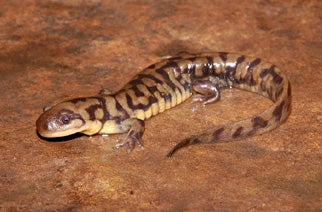SCIENTIFIC NAME:
Ambystoma tigrinum tigrinum
STATUS:
Uncommon to rare in all major regions except possibly the Piedmont, from which records are lacking. Seldom encountered except at temporary pools and woodland pools during winter breeding season. Populations disjunct, and habitat requirements poorly understood. HIGH CONSERVATION CONCERN.
DESCRIPTION:
The tiger salamander is the most widespread salamander species in North America. There are seven subspecies of tiger salamanders, but the eastern is the only one that occurs in Alabama. This salamander grows to be 7-13 inches long. Their coloration is quite variable with a dark gray or gray-brown back and yellowish blotches that extend down the sides. The belly is olive or yellow and may have dark specks.
The only other salamander that it might be confused with is the spotted salamander (Ambystoma maculatum). The spotted salamander, however, has two rows of regular, yellow-to-orange spots running parallel down its back. Male and female tiger salamanders are similar in appearance; except the female’s tail is shorter and does not flatten (side to side) like the males during the breeding season.
Tiger Salamanders have large robust bodies, broad flattened heads with relatively small eyes, sturdy legs and long tails. Each foreleg has four toes while their hind legs have five toes each. Tiger salamanders have 12-13 costal grooves along the side of the body.
DISTRIBUTION:
Eastern tiger salamanders range along the east cost from southern New York to northern Florida, west from Ohio to Minnesota and southward through eastern Texas to the Gulf. In Alabama their distribution is considered to be statewide or nearly so.
HABITAT:
Tiger salamanders need two types of habitats to survive – ponds for breeding and soft, moist earth for burrowing. Adult tiger salamanders spend most of their lives in underground burrows, as do other members of the group referred to as “mole salamanders.” These burrows are 2 to 6 inches below the surface and about the diameter of a quarter. Tiger salamanders do not burrow in groups, but several burrows may be in close proximity to each other if the soil is soft and moist.
FEEDING HABITS:
Adult tiger salamanders are voracious predators of both terrestrial and aquatic insects, as well as other invertebrates including earthworms, spiders, pill bugs and occasionally eggs or young of amphibians and reptiles. Larvae eat a wide variety of aquatic insects and invertebrates and about anything that will fit in their mouths, including other salamander larvae.
LIFE HISTORY AND ECOLOGY:
As adults, tiger salamanders are entirely terrestrial and usually only return to the water to breed. Like all mole salamanders they are very loyal to their birthplace and have been documented to travel up to a half mile in order to reach it. Breeding in Alabama occurs December through February. Males will start moving to breeding ponds following winter rains. They are followed soon after by the females.
Tiger salamanders typically choose clear, fish-free ponds that periodically go dry during the summer for breeding. These temporary or ephemeral pools generally produce lush vegetation that tiger salamanders need for cover and egg laying surfaces. Also, the lack of predatory fishes improves survival of larvae.
There is no amplexus, or clasping together, during breeding, instead courtship consists of a good deal of nudging, pushing and tail lashing by the male. Finally, males will crawl out ahead of the female and deposit a sperm packet called a spermatophore on the pond bottom. Interested females will glide over the spermatophore and pick it up through a vent on her underside and inseminate their eggs. Over a two or three night period females will lay 200 to 400 eggs, most often in small masses or clusters ranging from 10 to 100 eggs each. Egg masses are usually attached to plants, twigs or stones but may float free if the support is broken. The gelatinous outer covering of the eggs does not become firm as it does in spotted salamander egg masses. Eggs hatch in about 20 to 40 days, depending on water temperatures.
Larvae grow rapidly and usually transform, reabsorbing their gills and replacing their tadpole like tails with the rounded tail of an adult terrestrial salamander, in 4.5 to 5 months. Once transformed, young salamanders leave the breeding site during the next wet period.
Tiger salamanders are long-lived, living up to 20 years, but their average lifespan is 5 to 10 years.
REFERENCES:
Mount, R. H., 1975. The Reptiles and Amphibians of Alabama. Ala. Agri. Expt. Sta., Auburn Univ., Auburn, AL. 347 pp.
New York State Department of Environmental Conservation. “Eastern Tiger Salamander Fact Sheet” (On-Line). Accessed May 15, 2006 at www.dec.ny.gov/animals/7143.html.
The Georgia Museum of Natural History and the Georgia Department of Natural Resources 2000. “Georgia Wildlife Web Site: Eastern Tiger Salamander (Ambystoma tigrinum)” (On-line).
Virginia Department of Game and Inland Fisheries 2004. “Virginia Wildlife Information: Eastern Tiger Salamander (Ambystoma tigrinum)” (On-Line). Accessed May 15, 2006 at https://www.dgif.virginia.gov/wp-content/uploads/media/virginia-threatened-endangered-species.pdf
Wikepedia. “Tiger Salamander” (On-line). Accessed on May 15, 2006 at http://en.wikipedia.org/wiki/Tiger_Salamander.
Author: Ron Eakes, Wildlife Biologist, Division of Wildlife and Freshwater Fisheries.






